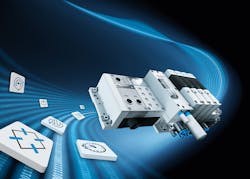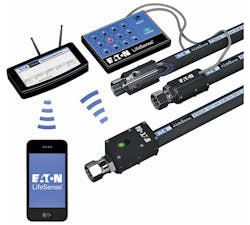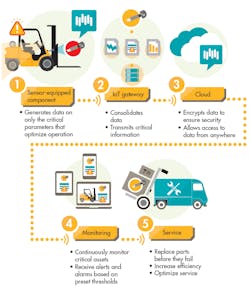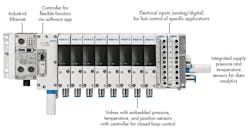Download this article in PDF format.
It seems nothing can escape the Internet of Things (IoT). We already see that sensors and data collection are becoming a natural part of our work and consumer environment. In the world of fluid power, IoT is impacting both the hydraulic and pneumatic sectors, especially in terms of direct monitoring and control via cloud analytics and smart devices. IoT features are being directly integrated into hoses, fittings, control valves, and pumps.
A recent report from BCC Research stated that the global market for instrumentation sensors used in fluid control would reach $16.2 billion by 2021, dramatically up from the $11.8 billion in 2016. Stationary applications represent the market with the largest growth potential, with forecasts of up to $15.9 billion by 2021. Mobile applications could see a major ramp-up in the fluid power world, too. Smartphone and tablet apps are expected to climb from a $243 million market in 2016 to $308.6 billion in 2021.
All aspects of the engineering industry have felt the impact of the Internet of Things. This includes the fluid power arena, as it offers the ability to monitor and control fluid valves, hoses, and pumps.
According to the report, in 2016, flow transmitters for fluid control in the process industries had a maximum share of 40.9%. Next on the list were level transmitters (25.5%), pressure transmitters (17.5%), and temperature transmitters (16.1). In 2021, flow transmitters are still expected to hold maximum share at 41%, followed by increases in level transmitters (25.3%), pressure transmitters (17%), and temperature transmitters (16.6%). Let’s examine three examples of how leading companies in fluid power are integrating monitoring and control via IoT applications.
Eaton LifeSense
Hose failures are common problems faced by hydraulic customers. They result in asset downtime, production loss, human safety concerns, environmental spills, equipment damage, and repair/replacement costs. For example, according to research conducted by Eaton, a hose failure can lead to $70,000 loss per hour for a steel mill, $3,000 loss per incident for a refuse truck, and $78,000 loss per day for a hydroelectric power plant.
To help its customers, Eaton developed a technology called LifeSense. LifeSense is an intelligent hydraulic-hose-condition monitoring system that detects hose failure events, and provides predictive maintenance notification when the hose is approaching the end of its lifecycle.
Eaton’s LifeSense system provides real-time monitoring for hydraulic hoses, arming users with predictive maintenance capability as hoses approach failure.
LifeSense operates on the premise that certain properties within the hose change as it approaches failure. Each hose fitting is equipped with a sensor that continuously monitors the hose’s condition; that data is then submitted to hose diagnostic unit (HDU) for analysis. The sensors used by LifeCycle compare samples of the hose properties during normal operation to establish a baseline. When the hose starts to behave below the normal baseline, it can predict when it will fail. An alert notification is generated when the hose is approaching failure.
Currently, LifeSense offers two approaches for hose monitoring: wired and wireless. The wired system can monitor up to 11 hose assemblies on a HDU. The HDU will receive visual alerts from 10 to 100 feet of standard cable lengths; the system operates on either 12- or 24-V direct current. The wireless system uses an IoT gateway and the HDU can monitor up to 100 hoses using a 433-MHz frequency communication protocol. Sensor battery life is a minimum of six years.
Alert notifications on the gateway can be sent immediately, and received via email or text message on either Wi-Fi or Ethernet. The wireless option also provides constant updates on the system’s performance. With the web portal, the user can access the collected data at any time. The IP67- and IP69K-protected sensor monitors the entire hose length, not just the fitting area. The LifeSense hose generates up to five times as many impulse cycles as required by SAE standards.
Parker’s Voice of the Machine
Parker Hannifin Corp. is looking to power the machines so that they have their own voice. Parker is top-tier hydraulic supplier, offering everything from hoses and fittings to pumps and valves. “The Voice of the Machine,” its IoT platform, was announced at Hannover Messe Fair in April 2017. The idea behind the platform is to standardize IoT technology across all of Parker’s products so that it becomes fully integrated into a customer’s business model.
The “Voice of the Machine” from Parker offers IoT monitoring in all of its products by directly embedding IoT as a standard feature. This gives users data analytics, monitoring, and predictive maintenance along the entire lifecycle.
The Voice of the Machine model works by installing sensors into Parker products. The data generated is only based on critical parameters that affect performance. The data is then transmitted to an IoT gateway that consolidates the data and transmits critical information. The cloud analytics offered by Parker analyzes, encrypts, and provides remote access to the data. Monitoring is available across all electronic platforms, including laptop, tablet, and smartphone access. Lastly, the IoT service provides predictive maintenance to replace parts before they fail, thus increasing efficiency and optimizing service quality.
In one example of the service, Parker’s IQAN Connect solution is used to create intelligent electrohydraulic components. The hardware located in these products provides a digital system that optimizes equipment performance and simplifies remote monitoring for original equipment managers and managers. The data is stored in the cloud and assets are managed in real-time with live diagnostics. The Voice of the Machine platform can be used in industries such as oil and gas, hydraulic power generation, renewable energy, municipal water and waste management, and chemical processing.
The Festo Motion Terminal
Smartphones and apps are the new way for engineers to control devices on the factory floor. Many companies have created apps to help monitor and provide real-time status of their IoT devices. The next step is to offer control over these devices via smartphones and tablets. Festo’s Motion Terminal apps give engineers direct control of smart devices. For the first time, a valve can be controlled using apps. To make this possible, Festo integrated flexible and programmable processors, as well as smart actuation technology.
For the first time, engineers have direct control over control valves via a smartphone app thanks to Festo’s Motion Terminal.
The new Motion Terminal helps replace up to 50 individual components. Four 2/2-way valves are connected in series to form a bridge with each diaphragm poppet valve piloted and controlled by two piezo valves. The sensors monitor the stroke of each poppet valve. The terminal’s pressure sensors make it possible to monitor up to 10 different applications, including model-based proportional pressure regulation, leakage diagnostics, supply and exhaust airflow control, and pressure levels and regulation.
For example, the Motion Terminal can offer fast and powerful movements as well as leakage diagnostics at a lower cost. Few controllers are required compared with other electrical solutions, since one controller can monitor and manipulate up to eight movements. Energy consumption is reduced when using the Motion Terminal, and installation space decreases by 65%.
Andy Parker-Bates, Product Manager at Festo, believes that “the Motion Terminal will revolutionize automation technology in much the same way that the smartphone turned the mobile communication market on its head a decade ago… transforming pneumatic products into true Industry 4.0 components, [the Motion Terminal] simplifies system design, reduces costs, and offers greater energy efficiency.”





